engine coolant Alfa Romeo 166 2007 Owner handbook (in English)
[x] Cancel search | Manufacturer: ALFA ROMEO, Model Year: 2007, Model line: 166, Model: Alfa Romeo 166 2007Pages: 272, PDF Size: 4.17 MB
Page 7 of 272
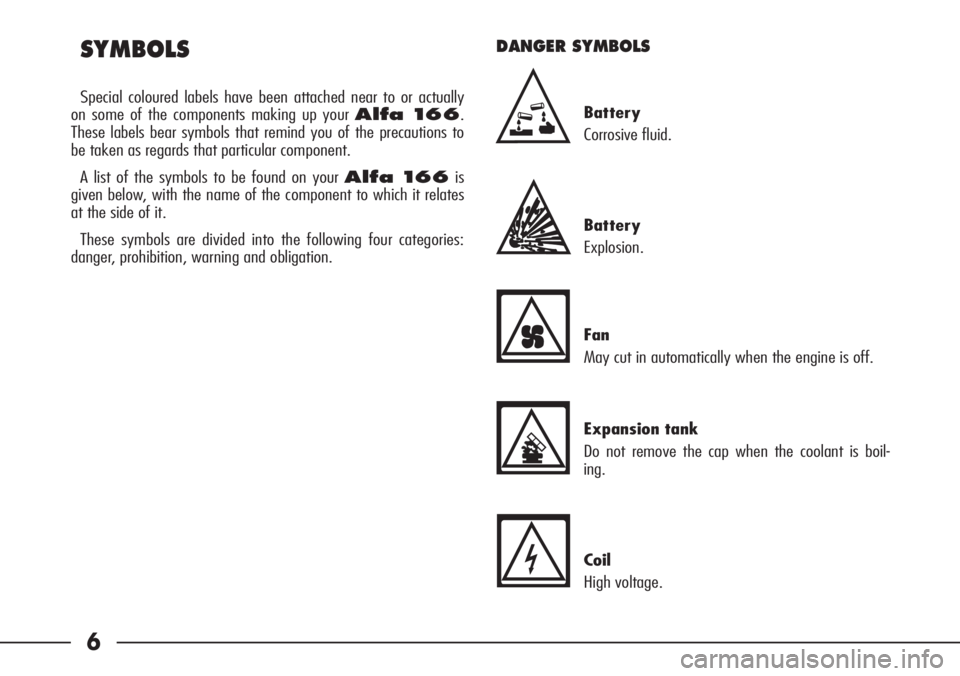
6 SYMBOLS
Special coloured labels have been attached near to or actually
on some of the components making up your Alfa 166.
These labels bear symbols that remind you of the precautions to
be taken as regards that particular component.
A list of the symbols to be found on your Alfa 166is
given below, with the name of the component to which it relates
at the side of it.
These symbols are divided into the following four categories:
danger, prohibition, warning and obligation.
DANGER SYMBOLS
Battery
Explosion.
Fan
May cut in automatically when the engine is off.
Expansion tank
Do not remove the cap when the coolant is boil-
ing.
Battery
Corrosive fluid.
Coil
High voltage.
Page 72 of 272
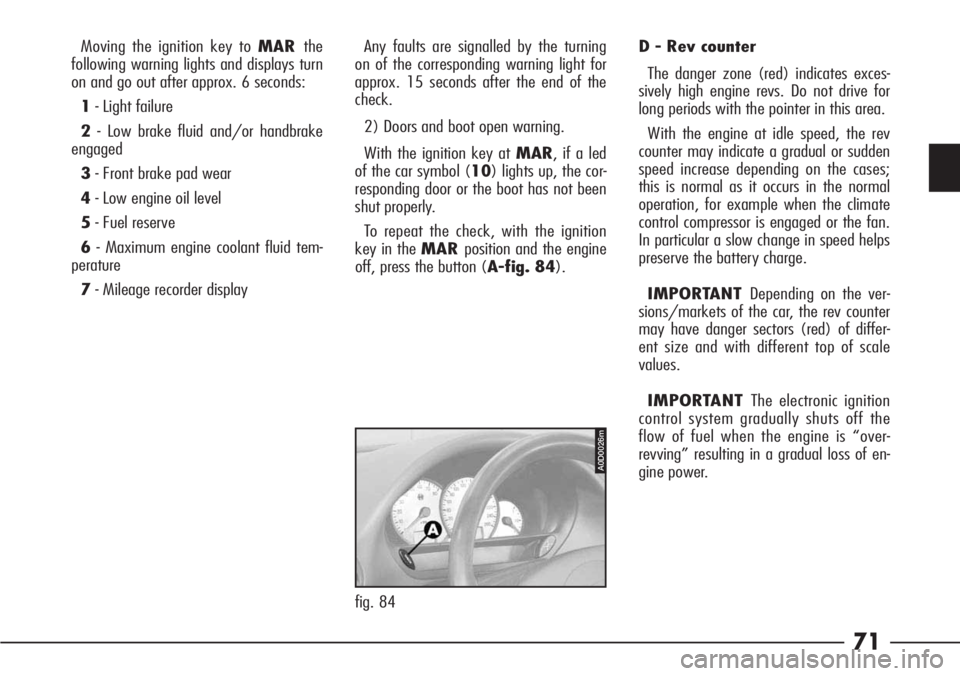
71
D - Rev counter
The danger zone (red) indicates exces-
sively high engine revs. Do not drive for
long periods with the pointer in this area.
With the engine at idle speed, the rev
counter may indicate a gradual or sudden
speed increase depending on the cases;
this is normal as it occurs in the normal
operation, for example when the climate
control compressor is engaged or the fan.
In particular a slow change in speed helps
preserve the battery charge.
IMPORTANT Depending on the ver-
sions/markets of the car, the rev counter
may have danger sectors (red) of differ-
ent size and with different top of scale
values.
IMPORTANT The electronic ignition
control system gradually shuts off the
flow of fuel when the engine is “over-
revving” resulting in a gradual loss of en-
gine power. Moving the ignition key to MARthe
following warning lights and displays turn
on and go out after approx. 6 seconds:
1- Light failure
2- Low brake fluid and/or handbrake
engaged
3- Front brake pad wear
4- Low engine oil level
5- Fuel reserve
6- Maximum engine coolant fluid tem-
perature
7- Mileage recorder displayAny faults are signalled by the turning
on of the corresponding warning light for
approx. 15 seconds after the end of the
check.
2) Doors and boot open warning.
With the ignition key at MAR, if a led
of the car symbol (10) lights up, the cor-
responding door or the boot has not been
shut properly.
To repeat the check, with the ignition
key in the MARposition and the engine
off, press the button (A-fig. 84).
A0D0026m
fig. 84
Page 73 of 272
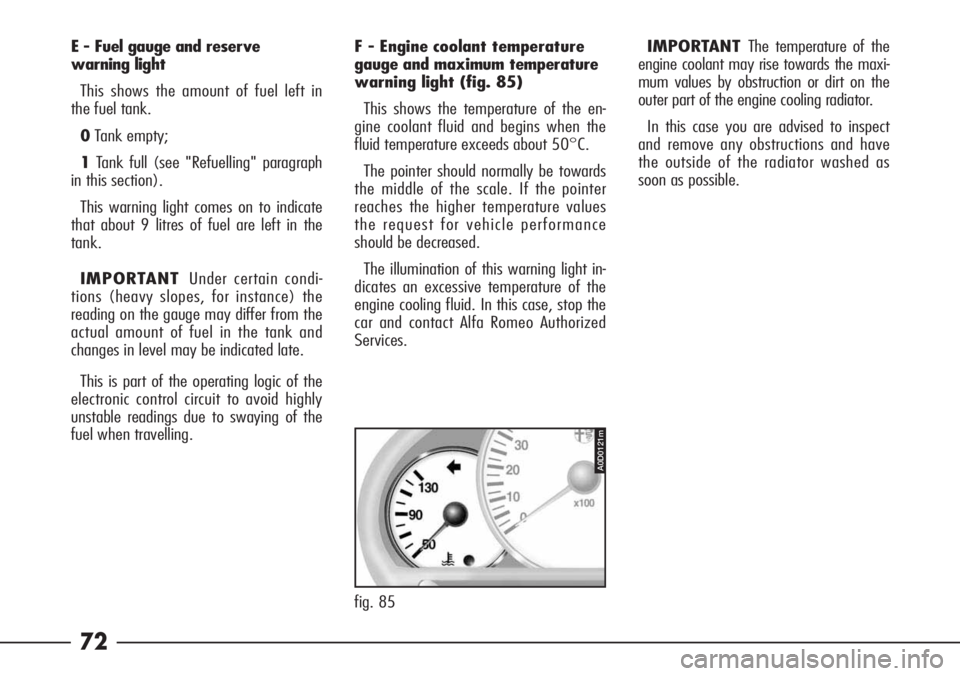
72
E - Fuel gauge and reserve
warning light
This shows the amount of fuel left in
the fuel tank.
0Tank empty;
1Tank full (see "Refuelling" paragraph
in this section).
This warning light comes on to indicate
that about 9 litres of fuel are left in the
tank.
IMPORTANTUnder certain condi-
tions (heavy slopes, for instance) the
reading on the gauge may differ from the
actual amount of fuel in the tank and
changes in level may be indicated late.
This is part of the operating logic of the
electronic control circuit to avoid highly
unstable readings due to swaying of the
fuel when travelling.F - Engine coolant temperature
gauge and maximum temperature
warning light (fig. 85)
This shows the temperature of the en-
gine coolant fluid and begins when the
fluid temperature exceeds about 50°C.
The pointer should normally be towards
the middle of the scale. If the pointer
reaches the higher temperature values
the request for vehicle performance
should be decreased.
The illumination of this warning light in-
dicates an excessive temperature of the
engine cooling fluid. In this case, stop the
car and contact Alfa Romeo Authorized
Services.IMPORTANT The temperature of the
engine coolant may rise towards the maxi-
mum values by obstruction or dirt on the
outer part of the engine cooling radiator.
In this case you are advised to inspect
and remove any obstructions and have
the outside of the radiator washed as
soon as possible.
fig. 85
A0D0121m
Page 92 of 272
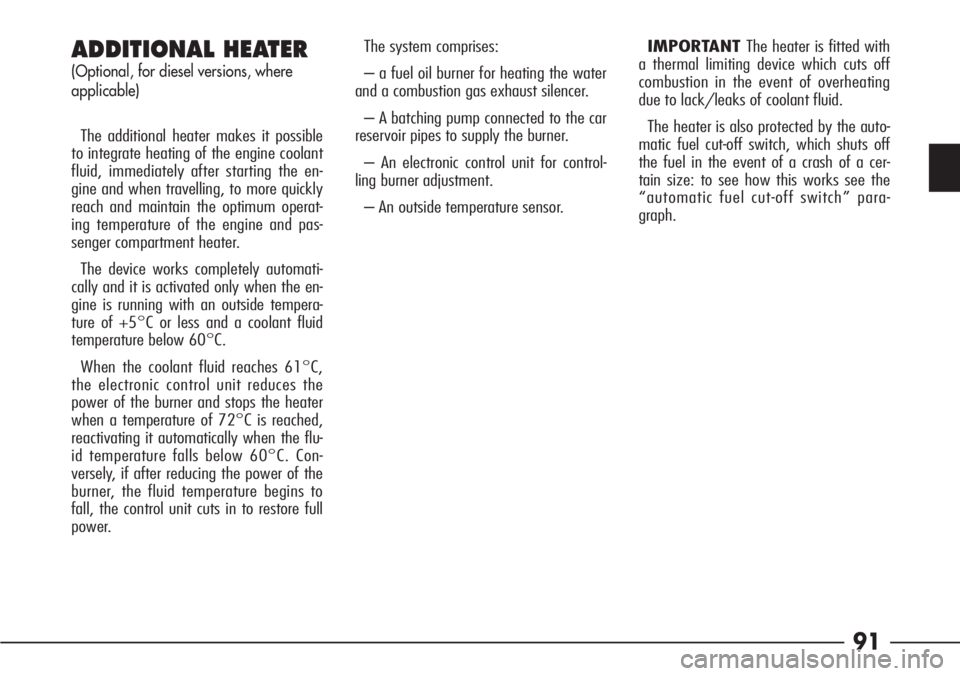
91
ADDITIONAL HEATER
(Optional, for diesel versions, where
applicable)
The additional heater makes it possible
to integrate heating of the engine coolant
fluid, immediately after starting the en-
gine and when travelling, to more quickly
reach and maintain the optimum operat-
ing temperature of the engine and pas-
senger compartment heater.
The device works completely automati-
cally and it is activated only when the en-
gine is running with an outside tempera-
ture of +5°C or less and a coolant fluid
temperature below 60°C.
When the coolant fluid reaches 61°C,
the electronic control unit reduces the
power of the burner and stops the heater
when a temperature of 72°C is reached,
reactivating it automatically when the flu-
id temperature falls below 60°C. Con-
versely, if after reducing the power of the
burner, the fluid temperature begins to
fall, the control unit cuts in to restore full
power.The system comprises:
– a fuel oil burner for heating the water
and a combustion gas exhaust silencer.
– A batching pump connected to the car
reservoir pipes to supply the burner.
– An electronic control unit for control-
ling burner adjustment.
– An outside temperature sensor.IMPORTANT The heater is fitted with
a thermal limiting device which cuts off
combustion in the event of overheating
due to lack/leaks of coolant fluid.
The heater is also protected by the auto-
matic fuel cut-off switch, which shuts off
the fuel in the event of a crash of a cer-
tain size: to see how this works see the
“automatic fuel cut-off switch” para-
graph.
Page 136 of 272
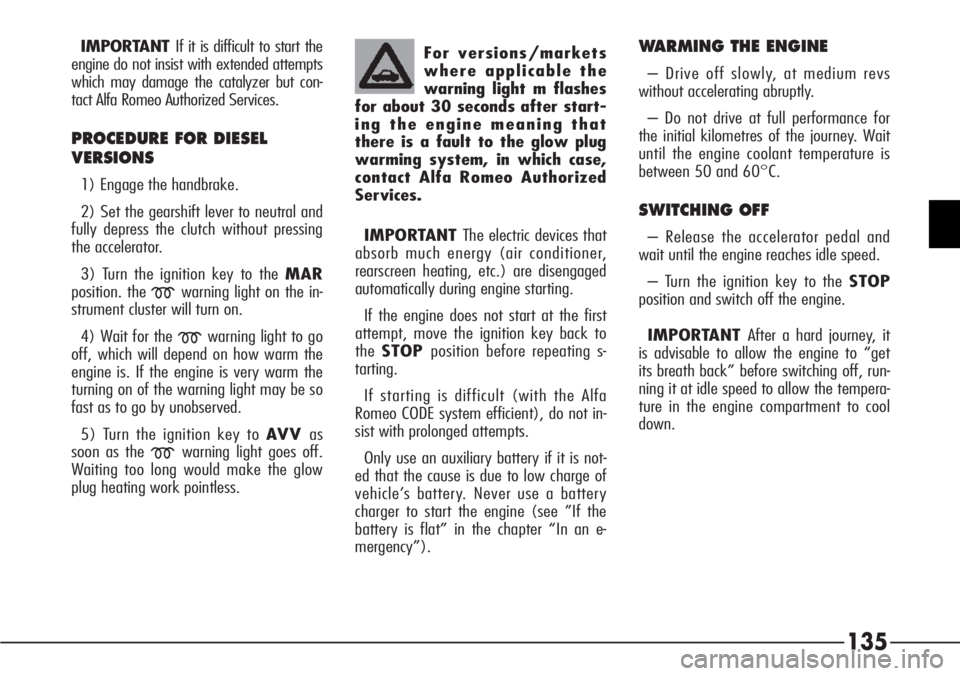
135
IMPORTANT If it is difficult to start the
engine do not insist with extended attempts
which may damage the catalyzer but con-
tact Alfa Romeo Authorized Services.
PROCEDURE FOR DIESEL
VERSIONS
1) Engage the handbrake.
2) Set the gearshift lever to neutral and
fully depress the clutch without pressing
the accelerator.
3) Turn the ignition key to the MAR
position. the
mwarning light on the in-
strument cluster will turn on.
4) Wait for the
mwarning light to go
off, which will depend on how warm the
engine is. If the engine is very warm the
turning on of the warning light may be so
fast as to go by unobserved.
5) Turn the ignition key to AVV as
soon as the
mwarning light goes off.
Waiting too long would make the glow
plug heating work pointless.IMPORTANT The electric devices that
absorb much energy (air conditioner,
rearscreen heating, etc.) are disengaged
automatically during engine starting.
If the engine does not start at the first
attempt, move the ignition key back to
theSTOPposition before repeating s-
tarting.
If starting is difficult (with the Alfa
Romeo CODE system efficient), do not in-
sist with prolonged attempts.
Only use an auxiliary battery if it is not-
ed that the cause is due to low charge of
vehicle’s battery. Never use a battery
charger to start the engine (see ”If the
battery is flat” in the chapter “In an e-
mergency”).
WARMING THE ENGINE
– Drive off slowly, at medium revs
without accelerating abruptly.
– Do not drive at full performance for
the initial kilometres of the journey. Wait
until the engine coolant temperature is
between 50 and 60°C.
SWITCHING OFF
– Release the accelerator pedal and
wait until the engine reaches idle speed.
– Turn the ignition key to the STOP
position and switch off the engine.
IMPORTANT After a hard journey, it
is advisable to allow the engine to “get
its breath back” before switching off, run-
ning it at idle speed to allow the tempera-
ture in the engine compartment to cool
down. For versions/markets
where applicable the
warning light m flashes
for about 30 seconds after start-
ing the engine meaning that
there is a fault to the glow plug
warming system, in which case,
contact Alfa Romeo Authorized
Services.
Page 140 of 272
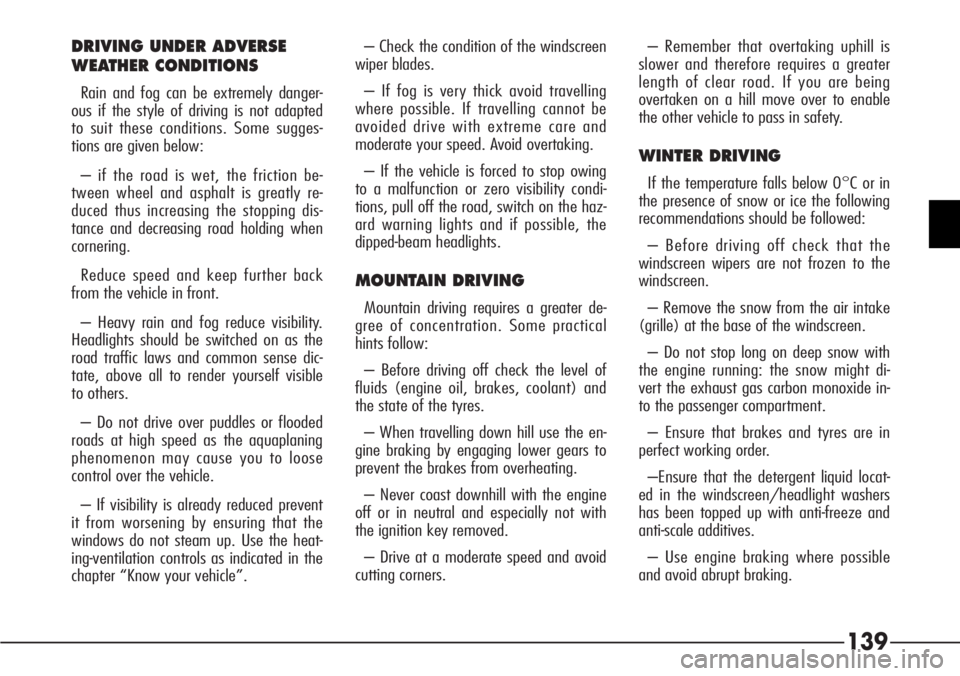
139
DRIVING UNDER ADVERSE
WEATHER CONDITIONS
Rain and fog can be extremely danger-
ous if the style of driving is not adapted
to suit these conditions. Some sugges-
tions are given below:
– if the road is wet, the friction be-
tween wheel and asphalt is greatly re-
duced thus increasing the stopping dis-
tance and decreasing road holding when
cornering.
Reduce speed and keep further back
from the vehicle in front.
– Heavy rain and fog reduce visibility.
Headlights should be switched on as the
road traffic laws and common sense dic-
tate, above all to render yourself visible
to others.
– Do not drive over puddles or flooded
roads at high speed as the aquaplaning
phenomenon may cause you to loose
control over the vehicle.
– If visibility is already reduced prevent
it from worsening by ensuring that the
windows do not steam up. Use the heat-
ing-ventilation controls as indicated in the
chapter “Know your vehicle”.– Check the condition of the windscreen
wiper blades.
– If fog is very thick avoid travelling
where possible. If travelling cannot be
avoided drive with extreme care and
moderate your speed. Avoid overtaking.
– If the vehicle is forced to stop owing
to a malfunction or zero visibility condi-
tions, pull off the road, switch on the haz-
ard warning lights and if possible, the
dipped-beam headlights.
MOUNTAIN DRIVING
Mountain driving requires a greater de-
gree of concentration. Some practical
hints follow:
– Before driving off check the level of
fluids (engine oil, brakes, coolant) and
the state of the tyres.
– When travelling down hill use the en-
gine braking by engaging lower gears to
prevent the brakes from overheating.
– Never coast downhill with the engine
off or in neutral and especially not with
the ignition key removed.
– Drive at a moderate speed and avoid
cutting corners.– Remember that overtaking uphill is
slower and therefore requires a greater
length of clear road. If you are being
overtaken on a hill move over to enable
the other vehicle to pass in safety.
WINTER DRIVING
If the temperature falls below 0°C or in
the presence of snow or ice the following
recommendations should be followed:
– Before driving off check that the
windscreen wipers are not frozen to the
windscreen.
– Remove the snow from the air intake
(grille) at the base of the windscreen.
– Do not stop long on deep snow with
the engine running: the snow might di-
vert the exhaust gas carbon monoxide in-
to the passenger compartment.
– Ensure that brakes and tyres are in
perfect working order.
–Ensure that the detergent liquid locat-
ed in the windscreen/headlight washers
has been topped up with anti-freeze and
anti-scale additives.
– Use engine braking where possible
and avoid abrupt braking.
Page 156 of 272
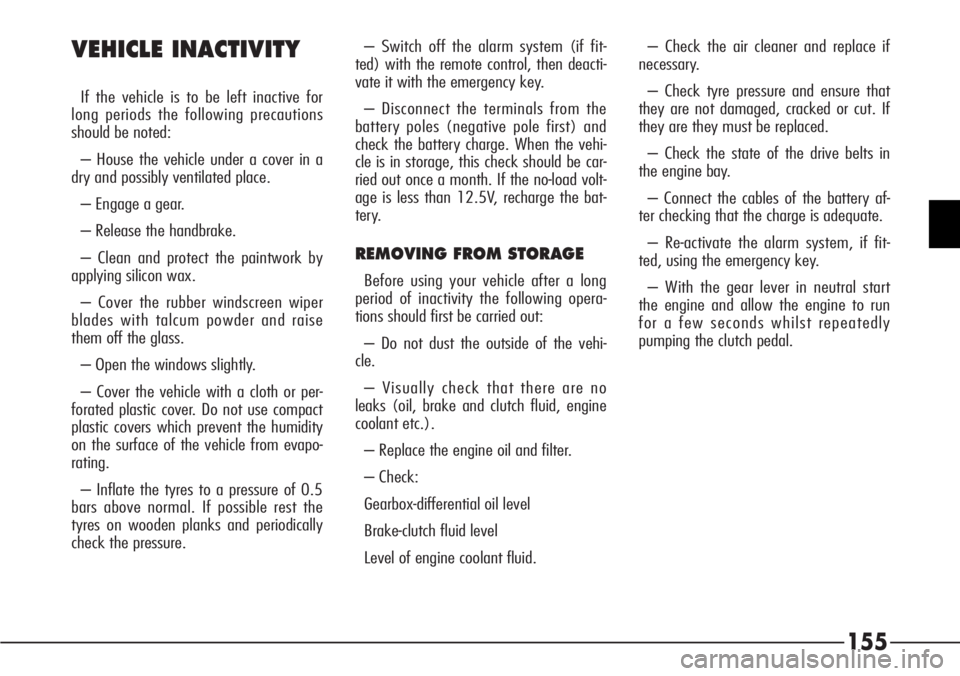
155 VEHICLE INACTIVITY
If the vehicle is to be left inactive for
long periods the following precautions
should be noted:
– House the vehicle under a cover in a
dry and possibly ventilated place.
– Engage a gear.
– Release the handbrake.
– Clean and protect the paintwork by
applying silicon wax.
– Cover the rubber windscreen wiper
blades with talcum powder and raise
them off the glass.
– Open the windows slightly.
– Cover the vehicle with a cloth or per-
forated plastic cover. Do not use compact
plastic covers which prevent the humidity
on the surface of the vehicle from evapo-
rating.
– Inflate the tyres to a pressure of 0.5
bars above normal. If possible rest the
tyres on wooden planks and periodically
check the pressure.– Switch off the alarm system (if fit-
ted) with the remote control, then deacti-
vate it with the emergency key.
– Disconnect the terminals from the
battery poles (negative pole first) and
check the battery charge. When the vehi-
cle is in storage, this check should be car-
ried out once a month. If the no-load volt-
age is less than 12.5V, recharge the bat-
tery.
REMOVING FROM STORAGE
Before using your vehicle after a long
period of inactivity the following opera-
tions should first be carried out:
– Do not dust the outside of the vehi-
cle.
– Visually check that there are no
leaks (oil, brake and clutch fluid, engine
coolant etc.).
– Replace the engine oil and filter.
– Check:
Gearbox-differential oil level
Brake-clutch fluid level
Level of engine coolant fluid.– Check the air cleaner and replace if
necessary.
– Check tyre pressure and ensure that
they are not damaged, cracked or cut. If
they are they must be replaced.
– Check the state of the drive belts in
the engine bay.
– Connect the cables of the battery af-
ter checking that the charge is adequate.
– Re-activate the alarm system, if fit-
ted, using the emergency key.
– With the gear lever in neutral start
the engine and allow the engine to run
for a few seconds whilst repeatedly
pumping the clutch pedal.
Page 203 of 272
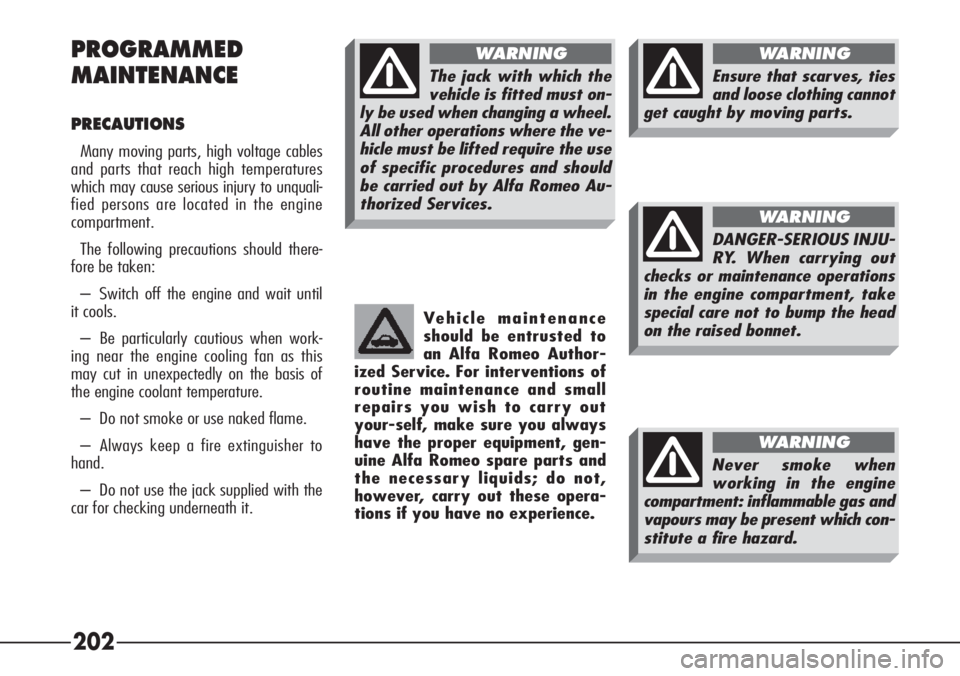
202 PROGRAMMED
MAINTENANCE
PRECAUTIONS
Many moving parts, high voltage cables
and parts that reach high temperatures
which may cause serious injury to unquali-
fied persons are located in the engine
compartment.
The following precautions should there-
fore be taken:
– Switch off the engine and wait until
it cools.
– Be particularly cautious when work-
ing near the engine cooling fan as this
may cut in unexpectedly on the basis of
the engine coolant temperature.
– Do not smoke or use naked flame.
– Always keep a fire extinguisher to
hand.
– Do not use the jack supplied with the
car for checking underneath it.Vehicle maintenance
should be entrusted to
an Alfa Romeo Author-
ized Service. For interventions of
routine maintenance and small
repairs you wish to carry out
your-self, make sure you always
have the proper equipment, gen-
uine Alfa Romeo spare parts and
the necessary liquids; do not,
however, carry out these opera-
tions if you have no experience.
The jack with which the
vehicle is fitted must on-
ly be used when changing a wheel.
All other operations where the ve-
hicle must be lifted require the use
of specific procedures and should
be carried out by Alfa Romeo Au-
thorized Services.
WARNING
Ensure that scarves, ties
and loose clothing cannot
get caught by moving parts.
WARNING
DANGER-SERIOUS INJU-
RY. When carrying out
checks or maintenance operations
in the engine compartment, take
special care not to bump the head
on the raised bonnet.
WARNING
Never smoke when
working in the engine
compartment: inflammable gas and
vapours may be present which con-
stitute a fire hazard.
WARNING
Page 206 of 272
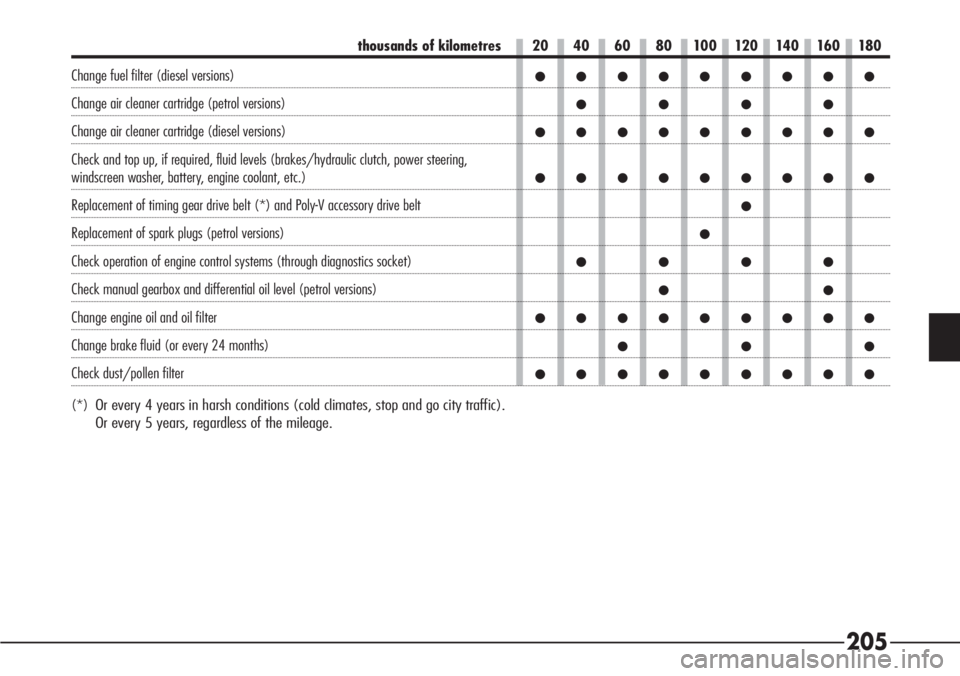
205
thousands of kilometres 20 40 60 80 100 120 140 160 180
Change fuel filter (diesel versions)•••••••••
Change air cleaner cartridge (petrol versions)••••
Change air cleaner cartridge (diesel versions)•••••••••
Check and top up, if required, fluid levels (brakes/hydraulic clutch, power steering,
windscreen washer, battery, engine coolant, etc.)•••••••••
Replacement of timing gear drive belt (*) and Poly-V accessory drive belt•
Replacement of spark plugs (petrol versions)•
Check operation of engine control systems (through diagnostics socket)••••
Check manual gearbox and differential oil level (petrol versions)••
Change engine oil and oil filter •••••••••
Change brake fluid (or every 24 months)•••
Check dust/pollen filter•••••••••
(*)Or every 4 years in harsh conditions (cold climates, stop and go city traffic).
Or every 5 years, regardless of the mileage.
Page 207 of 272
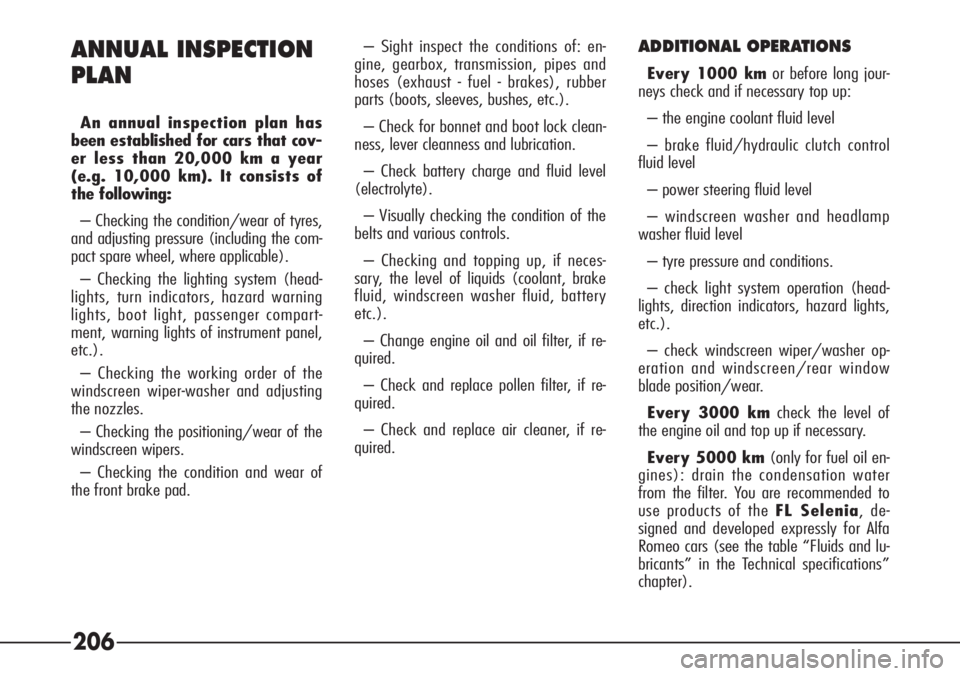
206 ANNUAL INSPECTION
PLAN
An annual inspection plan has
been established for cars that cov-
er less than 20,000 km a year
(e.g. 10,000 km). It consists of
the following:
– Checking the condition/wear of tyres,
and adjusting pressure (including the com-
pact spare wheel, where applicable).
– Checking the lighting system (head-
lights, turn indicators, hazard warning
lights, boot light, passenger compart-
ment, warning lights of instrument panel,
etc.).
– Checking the working order of the
windscreen wiper-washer and adjusting
the nozzles.
– Checking the positioning/wear of the
windscreen wipers.
– Checking the condition and wear of
the front brake pad.– Sight inspect the conditions of: en-
gine, gearbox, transmission, pipes and
hoses (exhaust - fuel - brakes), rubber
parts (boots, sleeves, bushes, etc.).
– Check for bonnet and boot lock clean-
ness, lever cleanness and lubrication.
– Check battery charge and fluid level
(electrolyte).
– Visually checking the condition of the
belts and various controls.
– Checking and topping up, if neces-
sary, the level of liquids (coolant, brake
fluid, windscreen washer fluid, battery
etc.).
– Change engine oil and oil filter, if re-
quired.
– Check and replace pollen filter, if re-
quired.
– Check and replace air cleaner, if re-
quired.
ADDITIONAL OPERATIONS
Every 1000 kmor before long jour-
neys check and if necessary top up:
– the engine coolant fluid level
– brake fluid/hydraulic clutch control
fluid level
– power steering fluid level
– windscreen washer and headlamp
washer fluid level
– tyre pressure and conditions.
– check light system operation (head-
lights, direction indicators, hazard lights,
etc.).
– check windscreen wiper/washer op-
eration and windscreen/rear window
blade position/wear.
Every 3000 kmcheck the level of
the engine oil and top up if necessary.
Every 5000 km(only for fuel oil en-
gines): drain the condensation water
from the filter. You are recommended to
use products of the FL Selenia, de-
signed and developed expressly for Alfa
Romeo cars (see the table “Fluids and lu-
bricants” in the Technical specifications”
chapter).